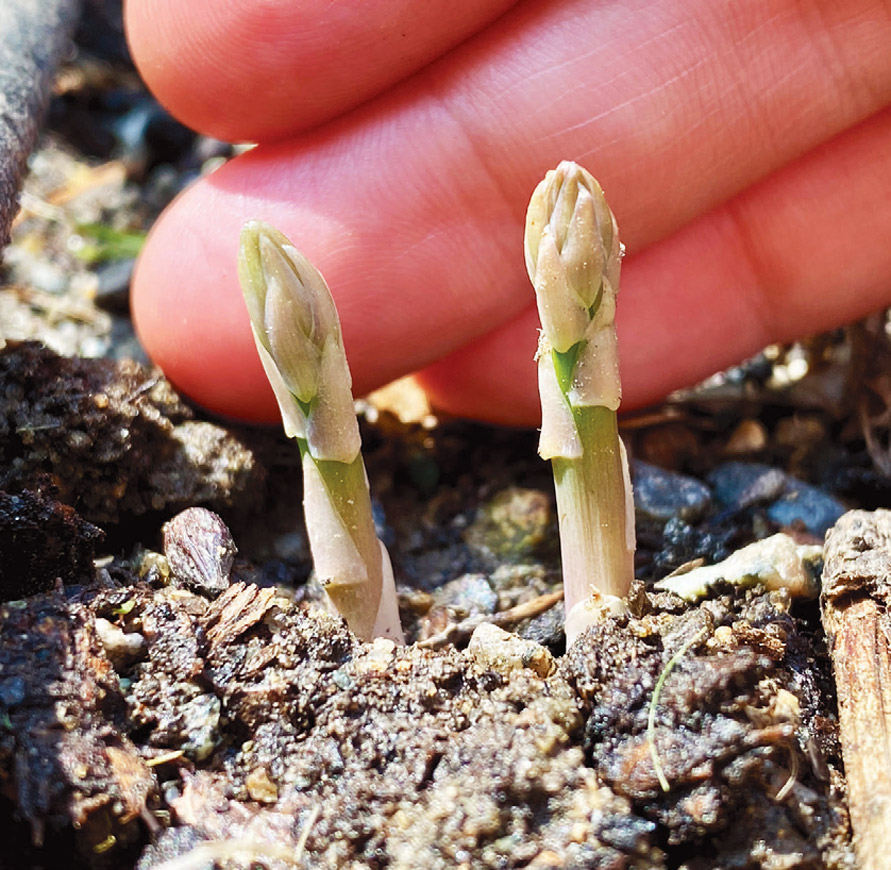The (Aromatic) Allure of Asparagus
Many people think robins hopping happily in their lawns, tugging plump earthworms out of the ground to bring back to their nests, are the first harbingers of spring. Or it’s when they notice it’s bright when they wake up to go to work, and it’s still bright when they log off their computers. Perhaps, it’s when grocery store florist departments are overflowing with tightly-bundled, yellow daffodils. But to me, it’s when I start seeing purple-tipped, bright green, tender asparagus spears move their way to the top of the menu at local restaurants and eateries, and when food markets are overflowing with them.
Asparagus, often touted as being an aphrodisiac, is not only a sexy vegetable (If you’ve ever seen asparagus being eaten in the movie, Dangerous Beauty, you’ll understand what I mean. But I digress.), but one that is rich in a myriad of vitamins and minerals. According to the U.S. Department of Agriculture (USDA), one cup of raw asparagus provides 32 mg of calcium, 70 mg of phosphorus, and 271 mg of potassium. It also provides 70 ug of folate, 51 ug of vitamin A, 56 ug of vitamin K, and 602 ug of beta-carotene among other things. In case you’ve forgotten what you learned in middle school about metric units of mass as I did, mg stands for milligrams and ug stands for micrograms. Suffice it to say, nutrients measured in micrograms are wicked small, but nonetheless still pack a powerful punch. Even when cooked, which is the preferred method to eat asparagus due to its relatively tough texture, it is considered to be a nutrient-rich vegetable.
A favorite hardy perennial in the vegetable garden, asparagus grows well in regions that are cool and have long winters. Gardeners who plant asparagus know that they have to be patient and exercise self-restraint. According to the Cape Cod Cooperative Extension and the University of Massachusetts at Amherst, “asparagus (Asparagus officinalis) is a member of the Lily Family and is a perennial vegetable that can thrive in the home garden for 25 years or more when properly cared for.” It’s easier to plant asparagus crowns (if you can find them in stores or online) versus attempting to grow them from seed. When the crowns and their long, skinny roots are spread apart, they resemble octopus tentacles. You’ll need to dig trenches, cover new shoots with more soil as the season progresses, and be extremely diligent about controlling weed growth. Asparagus grows best in fertilized, well-drained, sandy loam soil with a pH range of 6.5-7.0. You shouldn’t harvest any spears for the first few years until crops have had enough time to establish themselves. I planted asparagus crowns for the last year, and it was so challenging to not pick any of the skinny spears! But I know my future self will thank me. After a while, elegant ferns will grow from the spears. These ferns should only be cut back at the very end of the growing season, and after they have started to fade in color and to die back. This will ensure that depleted nutrients replenish starving root systems before the following season.
While green asparagus is most commonly found in our neck of the woods, if you are lucky, you may come across purple or white asparagus. Purple asparagus, a variety that originated in Italy and is popular in Europe, has a mild flavor and is sweeter than green asparagus. When it’s cooked, it loses its deep purple color, and turns predominantly green. White asparagus isn’t actually a different variety at all, but rather green asparagus that has been deprived of sunlight. If you place mounds of dirt on top of where you know established asparagus spears will begin to emerge, it will result in white asparagus. Lack of chlorophyll creates these beauties. Alluring, aren’t they?
Asparagus has played the role of muse since Roman times and in more places than just the kitchen. According to NPR, about a decade ago composer Ben Houge collaborated with Chef Jason Bond to create a musical piece entitled Super-Caramelized White Asparagus. It’s truly a delight to listen to and was composed in part “to explore and perhaps sharpen the relationship between food and music by letting the music describe the food.” This isn’t the first-time asparagus has inspired a culinary masterpiece. In 1880, Edouard Manet immortalized a bunch of asparagus with his still-life entitled, A Bunch of Asparagus. Its beauty is derived in its simplicity. A bundle of pale, pale green, purple-tipped asparagus, held together by what looks like pieces of twine, rest atop a bed of greens. The asparagus are not an afterthought, but rather the centerpiece. Based on this work of art, Manet appears to have preferred thick asparagus stalks over pencil-thin ones.
While there always seems to be heated debate over which size is most desirable, it comes down to personal preference, and realistically, what is most readily available when you get a hankering for them. Asparagus is extremely versatile and can be eaten raw, blanched, shaved, steamed, grilled, or roasted. You can even cook them in an air fryer. Most folks agree that the easiest way to ensure you are only eating the most tender parts of the asparagus, is if you take a spear in both hands, and bend it until it snaps. The bottom portion can then be discarded. (I typically throw mine in the compost tumbler, but they can even be frozen and used later in soups or sauces or cut thinly and added to stir-fries.) Each spear may snap in a different spot, and when lined up may not look perfectly uniform, but don’t let that deter you from adding them to your dinner party menu. Asparagus is best eaten soon after it’s bought or picked. If you do have to store it, wrap the ends in a damp paper towel, place them in a plastic bag, and keep in the refrigerator for up to three days. Alternatively, you can place the spears in a cup filled with about an inch of water.
When you find fresh asparagus in grocery stores or showcased on menus, don’t hold back. And, as most asparagus lovers know, but only whisper about in hushed tones, and never talk about at the dinner table, asparagusic acid can alter the scent of your, um, urine. While this may be temporarily unpleasant, it is perfectly normal. So, enjoy this early spring vegetable with abandon.






